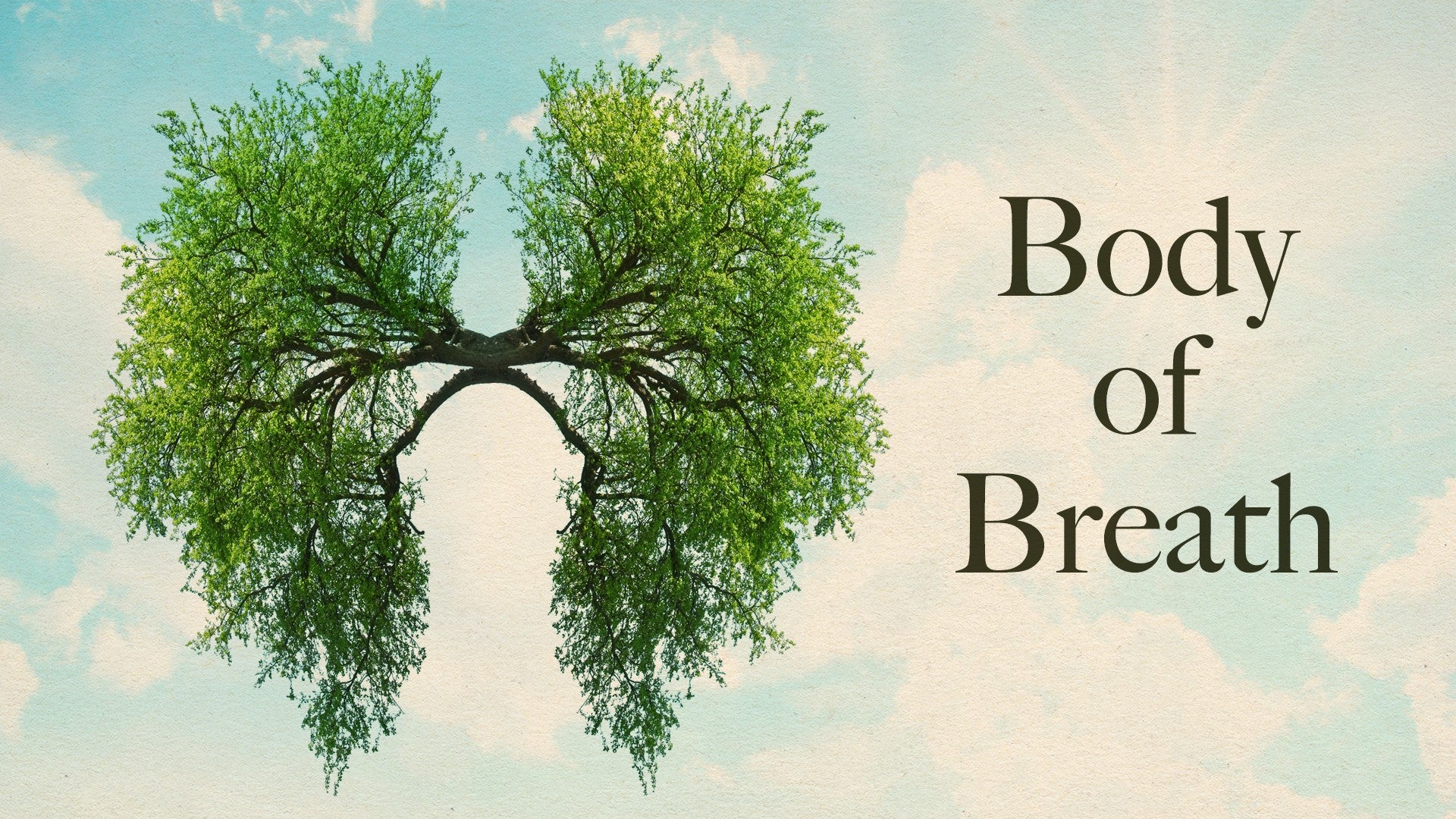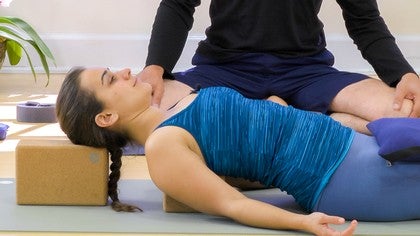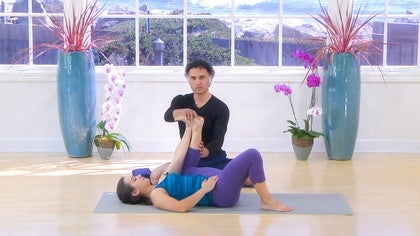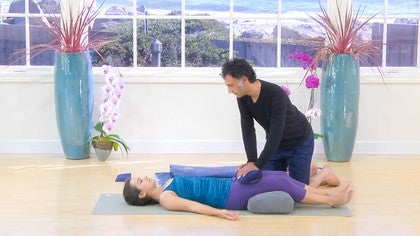Description
About This Video
Transcript
Read Full Transcript
So this is our third class, looking at the breath, looking at the breath in the torso, different parts of the body. Earlier we looked at the belly, we looked at the ribs and the diaphragm. Today we're going to be looking at the collar bones. So Junior and I are going to show you quite a simple sequence that you can do, hopefully finding a bit more openness in both the front and the back of your chest. So we will start with two blocks. You're going to need, throughout this class, you're going to need two blocks, a sandbag if you have one, an eye pillow is always a useful tool, and for the shavasana at the end, a bolster and a couple of blankets. So we'll start with these two blocks in this T shape. Junior, if you can put your shoulder blades on the block here and your head on the back there. So this pose, very naturally, puts the body in a position where you are going to create this opening in your upper chest, the broadening of the shoulder blades, and at the same time the block at the back brings movement of the shoulder blades into the back of the body. So you get the sense of the shoulder blades supporting you as your body settles, moving into the back of your body, and then this nice opening you get in the front chest, letting the shoulders broaden, slight external rotation in the arm bones, and in bringing your attention as you're breathing to your collarbones. And there's no need to be forcing the breath into collarbones, forcing your attention there. Simply notice how they are right now. Many people, there's very little movement in their upper chest and their collarbones in their breath, and rather than trying to push the sensation, push the movement there, certainly to start with, let's just approach this as bring your attention and beginning to relax whatever holding you may feel in the collarbones. And it's always nice to have a sandbag. Unless you have very patient, very quiet friends who are never going to bother you and sit here, sandbag is always helpful. And just observe, observe your own sensations in your upper chests in the collarbones. So for you, Juna, is this something that, is this area of your body that you naturally have a lot of sensation of? No, I'm not usually, I'm more aware of my lower belly and my breath moving in my lower belly. Right, so in these three classes we've done, the lower belly, the ribs and diaphragm maybe more make more sense to you. This is the class for you to really concentrate. And you all know your own bodies too, so which of these classes may be the one that's a little bit harder for you to do, one that you need a bit more attention on. So if, as we did in some of the earlier classes, little eye pillow is a great tool just to bring a little extra awareness somewhere. We had it before on the belly just to get a sensation of how your belly feels and today we can use it on the collarbones. How does that, how does that feel? Does that help you bring your attention there? It certainly brings my attention there. It's not very heavy, like more weight would help. So then there's this fine balance between the weight being there to help you focus your attention or if it's too heavy it's going to be weighing down on your chest. You obviously want the weight on the sandbags on your legs to ground the legs but for the upper chest we want this sense of buoyancy. The grounding principle is there for you from that solid foundation to then find this lightness and buoyancy and you know that can translate into this literal explanation of the breath in the body but also your life. From that solid grounded principle you can then flourish. So one of the purposes of doing these slightly longer poses to begin with is to get a sense of how it feels in your body to have this slight opening maybe an area that you're struggling with. So if you can hold on to how that feels, remember how that feels, going to gently transition out of this pose. I'll remove the sandbag you can roll over to one side and come on up to sit. Just pausing for a moment seeing how that feels in your collarbones. I feel like it gave me a lot of opening even just on the skin level. It was a good stretch. Right so you you often feel the first sensation is on the surface of your body on the skin and then it goes deeper and deeper and deeper layers of your body but also deeper layers of your sensitivity getting into your subtle body etc. So why don't you lie down once again in constructive rest. So knees bend feet flat on the floor and take your right ankle to your left knee and swing the legs over into a gentle twist. So even though we're concentrating on the collarbones in this class we're going to do a few poses that will open the side body and specifically open the hips because without opening your hips it's a struggle to bring any attention to your breath and taking this arm over head and feeling this stretch through the entire side body. So your thigh bone is moving forwards, the arm moving towards the back over your head and feeling the length through the side body. Remembering the class we did before that was concentrating on the side body, slowly building on these approaches.
Bringing your attention to where you may feel the most amount of tightness. Getting a sense of your torso moving sideways as well as forwards, backwards, this whole circumference diameter. So the same way as we looked at the pelvis, the same way as we looked at the diaphragm. Today we're going to look at the collarbones but that also includes a sense of opening in the back chest too. So bringing your arms back down, rolling the legs over, undoing the cross and taking the legs over to the opposite side and the arm overhead. And as always bringing your attention to the fact was this side easier than the other side, whether you know that naturally in your body, whether today something is different. So they're both those levels that it's always good to know the sort of foundation of your body, what the natural imbalances are and then begin to hone that to see how things change on a day-to-day basis. Again letting this thigh come forwards rather than pushing the twist to the ground, a sense of the thigh bone elongating out of the pelvis, the arms stretching up overhead and breathing into the side body where you feel any constriction. And bring the arm back down, legs back to neutral. So as I said hip openers central to any observation of the breath, any opening of the body. So we're not going to concentrate on that today but a few hip openers always a good idea. Take this leg into half happy baby, taking hold of the outside of the foot, letting the leg weigh down but again not not pushing too hard, just encouraging the leg to release. So last class when we were working on the on the hips it was your left hip that felt more tightness. Have you noticed any change in that in the in the few days in between? Yeah so it's a long-term pattern in you. So we'll look right now do the same in your body, see how this leg is positioned, what the sensations are, how easy the pose is and then releasing this leg, taking the other leg and immediately there's this there's a sense of more freedom in her body here more more openness. So this is something that Juna could work on on a long-term basis and the same with you look at which hip may be a bit more open which have a bit more constriction and this is a long-term project as I'm saying don't try and fix that in a week it probably took you years to get there so take the same amount of time getting out of it. So releasing that leg and pausing as always in constructive rest, bringing your attention to your breath and as we're going to do today in the whole class bring your attention to whatever sensations and whatever movement you feel in your collarbones. So we can see as Juna had explained earlier that collarbones not a natural part of her body to receive the breath. So if that's the case with you take your time and take a sense of a sense of gentleness and openness to work on this not this sense of forcing because you could take a big breath now and make your collarbones move. Does that feel comfortable? No. So you get a sense of movement but this is not what we're looking for we're looking for ease in the breath. I can feel them suddenly moving up and down. Beginning to right yeah. So rolling over to one side and coming in up to sit in Virasana. So we're going to do a couple of very simple movements with the arms. I like to do myself most days bringing awareness and opening both to the front of the chest, the shoulders and of course the back body which is an essential part of the idea of opening the front chest. It's also making sure there's space and movement in the back of your body. So start by taking your right arm up overhead feeling that length keeping weight in the thigh bone and dropping the palm to your shoulder and pausing here for a moment making sure you find as much length as you can in this side bringing the elbow up and then towards your head then taking the other hand strong internal rotation and clasping your hands at the back or if you need to you can always take a strap to make the clasp but I think it's better to make that connection rather than just leave the hands a few inches apart. Feeling what this pose does to the sense in the right side of the chest, the left side of the chest, the natural thing here is for this shoulder to roll forwards. So get any sense of opening in this front left side of the chest that you can and that can simply be bringing your attention there noticing how perhaps that shoulder is rolling forwards and if you can't move it out just get a sense of a bit more freedom a bit more openness there and releasing the hands and taking the pose on the other side again the length first dropping the palm to the shoulder blade finding the length in that arm through the whole shoulder girdle and the arm moving towards your head then taking the internal rotation and the clasp behind. Did you notice a greater ease on one side than the other? The first side is easier.
Yeah the shoulder looks a little bit more constricted here. I think it's actually my right shoulder. It's your right it's the rotating hmm that direction. Right. So know your own body notice it keep bringing the observations into your yourself in these poses. So letting the arms go pausing just for a moment bringing your awareness to the front chest and the back chest. So now we're going to look at the the back of the upper chest with with Garudasana arms so twining the arms bringing the palms together focusing your attention the space between the shoulder blades. Again with the inhalation and exhalation. If there's any movement there at all in your own body. So begin by simply observing what is and in this pose you may want to give a little bit more encouragement directing the breath perhaps a bit more forcefully between the shoulder blades or you can come into a forward band rounding the back body pushing some energy and some movement between the shoulder blades. Slightly more forcefully directing the breath there and then letting the hands fall and see how it feels. You get a sense that's brought more attention between your shoulder blades. Yeah it's a big stretch back there. It's a big stretch yeah good. So let's do the other side. Same thing again settling into the pose just observing what is the sensation in your body then maybe lifting the elbows a bit coming forwards a bit pushing into there directing the breath a bit more directly with a bit more force. These kind of poses this kind of exploration you want to stay a bit longer in that pose go ahead spend a bit more time there see what is what is happening otherwise coming out of the pose resting the arms feeling the sensation first of all in your back body and then the collarbones in the front and just feel for yourself which part of the chest front or back chest feels more open which part feels a bit more constricted. My sternum actually feels much more open after that. The sternum feels more open right in the center. So whichever direction feels more open can take your arms interlacing the fingers bringing the arms forwards if what you need is a bit more sensation in the back body otherwise do the opposite if the if the front feels like you need a bit more of an opening in here taking the arms behind you lifting the hands towards the ceiling as much as is comfortable then bringing the hands back to neutral and seeing if that's helped you find a bit more balance you might want to do that once or twice backwards and forwards just getting a bit more openness here a bit more awareness there. So we're going to do a very simple twist if you want to bring your hips across to the left side taking a blanket under the under the left hip to keep the pelvis more neutral making sure the top foot is in the arch of the lower foot and then bringing the right arm across the body opening up into the twist taking the gaze over the right shoulder from the grounding of the legs as always finding length through the torso so the twist comes from this very long torso and bringing your attention to this proud opening of the collar bones and coming out of this twist transitioning through bada kunasana to take the twist on the other side taking the blanket to support the hip arm across the body opening up into the twist finding this broadness both front and back through the chest so if you turn around on your mat and come into child's pose with your arms extended forwards taking the block between your hands finding the length through the body first bringing your attention to the back body here feeling the broadness and then taking the block towards your shoulder blades make sure there's a good amount of pressure on your hands on the block if you notice if you put more pressure on the thumb side or the pinky side of your hands different awareness through the front and back of the shoulder blades so just play with that a little bit see how it feels in your own body this feels easy to you you can bring the elbows a little bit further forwards getting a greater opening through the side body through the shoulder and remembering to keep the pressure on the block bringing the hands back down to the ground letting go of the block coming up into downward dog from here walking your feet to your hands pausing in Uttanasana for a moment and coming on up to stand in Tadasana so standing in Tadasana for a moment starting with your awareness in your belly finding the grounding of your legs from the sense of your belly and the sense of lifting through the torso into your collarbones and your back body so I always like to look at whatever part of the body we're concentrating on in both the seated and standing position we're more familiar in our daytime probably with standing walking around so it gives us the opportunity to become familiar with these sensations being able to find them again in our in our day-to-day lives so start by simply observing as you have been doing the sensations front and back of your chest then taking your thumbs into your armpits opening up the front chest for bankers pose finding this lifting here the front chest and the shoulder blade moving into the back body same on both sides but at the same time this pose is not for you to squeeze the shoulder blades together in the back body you still want to feel this broadness between the shoulder blades as we've been looking at before so letting the arms fall again as we did earlier extending the arms forwards or backwards trying to get a sense of which part of our chest felt more open start by taking your arms wide bending your fingers back and getting a sense of the the opening through the whole front body through the arms into the fingertips in traditional chinese medicine there are a lot of meridians coming from the center of the chest through the arms into the fingers and this is a great way to find some more of connections we're looking primarily at the collarbones right now but of course there are these connections throughout the whole body so feeling this your arm your hands seem to be pretty open do you get a strong sensation through this through my fingers and all the way yeah not so much through my pinkies hmm so see if you can get a little bit more movement in the pinky and now taking the arms in the opposite way across the body finding that same connection from this area in the back through the outside of the arms through the fingers sometimes to find more sensation in the hands and fingers you can bring your fingers together like this bringing the palms back so you get this opening all the way through the hands through the fingers and you can observe in your own body do you feel this connection all the way through the outside of the arms through the fingers and if you don't just bring your attention to whatever you do feel and just know that this connection is there and relaxing the arms seeing if that simple exercise connecting the arms to this area that we've been looking at front and back of the arms to the front and back of the chest has given you any extra sense of sensation it has especially along the armpits the upper armpits great so coming to stand at the front of your mat facing facing this way taking the arms taking your hands on your hips folding forwards keeping the front body long into uttanasana ah pausing there bringing the hands to the ground and stepping back into downward dog it's pausing there for a moment so from down dog coming into upward facing dog keeping the legs very strong but really concentrating on this broadening and opening of the front chest and coming back down to lie on your belly pausing there for a moment and then come up into sphinx pose so you're going to rest your elbows your forearms on the ground have the elbows under your shoulders and with your palms pull the arms back slightly slight external rotation of the arm bones and allow that external the rotation of the arm bones to really pull your chest forwards into this pose whilst keeping the back in a comfortable safe position coming back down resting the forehead on the ground and repeating that pose once again elbows underneath the shoulders using the traction of the floor pulling the arms back towards you slightly and broadening the chest by the external rotation of the arms deep in the shoulder joint and then just rolling onto your back so the last pose we're going to do is a supported bridge pose so starting in constructive rest find the neutral position bring your attention to your breath feel the support of the ground underneath you then lifting the pelvis up and placing a block underneath your sacrum making sure the sacrum is fully supported in this pose and this slight elevation really helps open the chest so as you settle into this pose bring your attention for the last time to the broadening of the open upper chest also make sure your back body is broad in this pose too there's a there's a tendency to bring the shoulder blades tight together in in this pose in the under body but try and find as much broadness front and back of the chest and now simply bring your attention to how the collarbones are moving this is how we we started this sequence notice the change that may have occurred in your own body do you feel a difference in your collarbones i don't feel more movement but i feel like the breath is penetrating higher so it feels more open so as i was saying at the beginning of class this isn't something that you're going to change instantly if this is a tight area of your body but simply bringing awareness to it can change this the the sensations that you're feeling and over time you'll find a greater and greater opening so taking the block out and lying back down for shavasana so as we're looking at the breath today i suggest we do shavasana with a bolster it causes it creates much more openness and ease in the belly which in turn will connect to opening the collarbones with the breath and you can also add a sandbag for extra grounding of the head of the thigh bones bring your attention to your breath noticing how your belly is moving how the ribs the diaphragm are moving how your collarbone is moving so normally we would stay in this pose for five ten minutes and i would suggest you you do that yourselves but right now we're going to come out to the pose very gently removing the sandbag bending one leg then the other leg rolling over to one side and coming on up to sit pausing at the end of your practice pausing for a moment not jumping up off the mat straight into your daily life and seeing how your body feels after this this brief practice what changes do you feel specifically for today's class what changes do you feel in your collarbones in the space between your shoulders and in the welcoming of the breath to your upper chest i feel a lot more ease in my breath actually and my shoulders feel like they've relaxed that's great so even though there's not a lot more movement you can't feel the the sensation that the obvious sensation on a subtler level it's beginning to open the changes are beginning to happen so gradually your body will change with repeated practice
Body of Breath
Comments
You need to be a subscriber to post a comment.
Please Log In or Create an Account to start your free trial.








